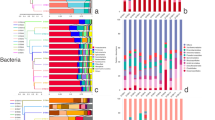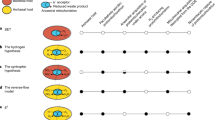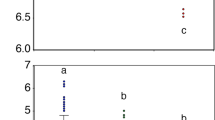Abstract
Aerobic and aerotolerant organisms have evolved defenses against the toxic effects of molecular oxygen1. One protective mechanism involves the breakdown of the harmful superoxide radical by the enzyme superoxide dismutase (SOD). However, levels of oxygen elevated only slightly above normal atmospheric (P O2 of 159 mm Hg) may overpower a cell's defense systems2–4. Although most animals do not naturally encounter oxygen pressures above 1 atm, hyperbaric oxygen levels normally occur in the tissues of marine animals that harbour intracellular algal symbionts, which in light generate more oxygen than is consumed by the combined host and symbionts5–10. We have now found that sea anemones Anthopleura elegantissima (Brandt) containing zooxanthellae (the symbiotic dinoflagellate Symbiodinium microadriaticum) in their gastrodermal tissues have SOD activities nearly two orders of magnitude greater than individuals totally lacking zooxanthellae.
This is a preview of subscription content, access via your institution
Access options
Subscribe to this journal
Receive 51 print issues and online access
$199.00 per year
only $3.90 per issue
Buy this article
- Purchase on SpringerLink
- Instant access to full article PDF
Prices may be subject to local taxes which are calculated during checkout
Similar content being viewed by others
References
Halliwell, B. Cell Biol. int. Rep. 2, 113–128 (1978).
Fridovich, I. Science 27, 462–466 (1977).
Yagi, K. & Ohishi, N. in Biochemical and Medical Aspects of Active Oxygen (eds Hayaishi, O. & Asada, K.) 299–307 (University of Tokyo Press, Tokyo, 1977).
Barthelemy, L., Beland, A. & Chastel, C. Resp. Physiol. 44, 261–268 (1978).
Pearse, V. B. Biol. Bull. 147, 641–651 (1974).
Wethey, D. S. & Porter, J. W. in Coelenterate Ecology and Behavior (ed. Mackie, G. O.) 59–66 (Plenum, New York, 1976).
Crossland, C. J. & Barnes, D. J. Mar. Biol. 40, 185–194 (1977).
Svoboda, A. & Porrmann, T. in Nutrition in the Lower Metazoa (eds Smith, D. C. & Tiffon, Y.) 87–99 (Pergamon, New York, 1980).
Trench, R. K., Wethey, D. S. & Porter, J. W. Biol. Bull. 161, 180–198 (1981).
Mangum, C. P. & Johansen, K. Pacific Sci. (in the press).
Trench, R. K. A. Rev. Pl. Physiol. 30, 485–531 (1979).
Muscatine, L. in Primary Productivity in the Sea (ed. Falkowski, P. G.) 381–402 (Plenum, New York, 1980).
Hill, H. A. O. Ciba Fdn Symp. 65, 5–17 (1979).
Halliwell, B. in Superoxide and Superoxide Dismutases (eds Michelson, A. M., McCord, J. M. & Fridovich, I.) 335–349 (Academic, New York, 1977).
Fee, J. A. in Biological and Clinical Aspects of Superoxide and Superoxide Dismutase (eds Bannister, W. H. & Bannister, J. V.) 41–48 (Elsevier, Amsterdam, 1980).
Fridovich, I. Science 201, 875–880 (1978).
Roos, D. & Weening, R. S. Ciba Fdn Symp. 65, 225–262, (1979).
Hassan, H. M. & Fridovich, I. in Enzymic Basis of Detoxication (ed. Jakoby, W. B.) 311–332 (Academic, New York, 1980).
Trench, R. K. Proc. R. Soc. B177, 237–250 (1971).
Fitt, W. K. & Pardy, R. L. Mar. Biol. 61, 199–205 (1981).
Asada, K., Kanematsu, S. & Uchida, K. Archs Biochem. Biophys. 179, 243–256 (1977).
Steele, R. D. J. Zool. Lond. 179, 387–405 (1976).
Muscatine, L., McCloskey, L. R. & Morian, R. E. Limnol. Oceanogr. 26, 601–611 (1981).
Pearse, V. B. Biol. Bull. 147, 630–640 (1974).
Fredericks, C. A. Mar. Biol. 38, 25–28 (1976).
Shick, J. M. & Brown, W. I. J. exp. Zool. 201, 149–155 (1977).
Fridovich, I. & McCord, J. J. biol. Chem. 244, 6049–6055 (1969).
Tyler, D. D. Biochem. J. 147, 493–504 (1975).
Marshall, M. J. & Worsfold, M. Analyt. Biochem. 86, 561–573 (1978).
Jeffrey, S. W. & Humphrey, G. H. Biochem. Physiol. Pflanzen. 167, 191–194 (1975).
Yentsch, C. S. & Menzel, D. W. Deep-Sea Res. 10, 221–231 (1963).
Itzhaki, R. F. & Gill, D. M. Analyt. Biochem. 9, 401–410 (1964).
Bradford, M. M. Analyt. Biochem. 72, 248–254 (1976).
Author information
Authors and Affiliations
Rights and permissions
About this article
Cite this article
Dykens, J., Shick, J. Oxygen production by endosymbiotic algae controls superoxide dismutase activity in their animal host. Nature 297, 579–580 (1982). https://doi.org/10.1038/297579a0
Received:
Accepted:
Issue date:
DOI: https://doi.org/10.1038/297579a0
This article is cited by
-
Longevity strategies in response to light in the reef coral Stylophora pistillata
Scientific Reports (2020)
-
Oxygen: the universal currency on coral reefs
Coral Reefs (2019)
-
N2 fixation, and the relative contribution of fixed N, in corals from Curaçao and Hawaii
Coral Reefs (2019)
-
Diazotroph diversity and nitrogen fixation in the coral Stylophora pistillata from the Great Barrier Reef
The ISME Journal (2018)
-
The colorful mantle of the giant clam, Tridacna squamosa, expresses a light-dependent manganese superoxide dismutase to ameliorate oxidative stresses due to its symbiotic association with zooxanthellae
Coral Reefs (2018)



